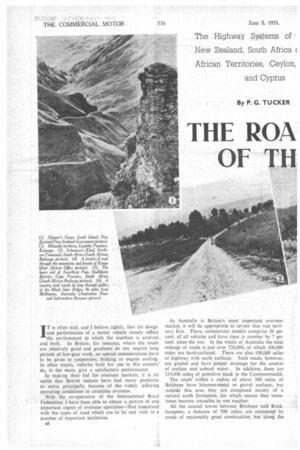THE ROA OF TH
Page 42

Page 44

If you've noticed an error in this article please click here to report it so we can fix it.
IT is often said, and I believe ,rightly, that the design and performance of a 'motor vehicle closely reflect the environment in which the machine is evolved., and built. In Britain, for instance, where the roads are relatively good and gradients do not require long periods of low-gear work, no special considerations have to be given to suspension, braking or engine cooling. In other words, vehicles built for use in this country" do, in the main, give a satisfactory performance.
In making their bid for overseas markets, it is tio secret that British makers have had many problems to solve, principally because of the widely differing operating conditions-in countries overseas.
With the, co-operation of the International Road Federation I have been able to obtain a.,_ picture of one important aspect of overseas operation—that concerned with the types of road which-are, to be met with in a
number of important territories. • As Australia is Britain's most important overseas market, it will be appropriate to review that vast territory first. There, commercial models comprise 36 per cent. of all vehicles and have risen in number by 7 per cent. since the war. In the whole of Australia the total mileage of roads is just over 528,000, of which 100,000 miles are hard-surfaced. 'There are also 108,000 miles of highway with earth surfaces.' Such roads, however, are graded and have proper drainage for the control of surface and subsoil water. In addition,. there are 319,000 miles of primitive track in the Commonwealth.
The roads within a radius of about 300 miles of Brisbane have bitumen-metal or gravel surfaces, but outside this area they are composed mainly of a natural earth formation, for whichreason they sometimes become unusable -in. wet weather.
All the coastal towns between Brisbane and -Rockhampton, a distance of 500 'miles, are connected by roads of reasonably good construction,* but •alOng the
In normal circumstances the main-road system can be considered "all-weather," but on journeys which necessitate leaving a main road, it is sound policy to obtain the latest road reports, as communications may easily become dislocated overnight as the result of heavy rain causing flooded drifts.
Kenya is a poor country for motor vehicles, as the roads, in the main, are suitable only for animal-drawn vehicles. Although improvements are being made as fast as economic conditions will allow, the high percentage of roads with rough and uneven surfaces almost rules out safe travel by normal types of vehicle.
In South Rhodesia there are 15,600 miles of roads, of which 2,500 miles are "stripped" or matted with a bitumen or tarred surface. There is, however, a well developed system of allweather main and feeder roads.
Of the three British Central African territories, the least developed in the matter of roads is Nyasaland, which has about 4,000 miles of road, of which some 1,500 miles are usable throughout the year. Between December and May the remainder are liable to become impassable because of severe flooding. By way of contrast, the road surfaces in the Bergian Congo are claimed to be superior to the ordinary roads in Africa. Extensive use has been made of Bailey bridges across rivers, and in 1948-49 well over two miles of such structures were erected.
Of the 32,800 miles of roads in Algeria, 17,750 miles, including 28 main highways of a total length of 4,315 miles, can be described as excellent. Of " improved " roads (those which are graded and drained), there are just under 12,000 miles. The total mileage of primitive tracks is 16,600.
The main trunk roads in Nigeria are reported to be in excellent condition, that from Lagos, via Abeolcuta, to Madan being tarred throughout its length. This road carries about 1,500 vehicles a day.. Going farther east to Ceylon, here is a country which once boasted the finest roads east of Suez. It is doubtful, however, whether this holds good to-day. When the roads were originally set out, the easiest track was invariably followed, which resulted in a number
of acute bends needing careful negotiation. In the main, gradients, even in the hill country, are moderate.
The width of the roads is frequently inadequate and camber is generally excessive, in some cases to an extent that makes driving dangerous. The loading of vehicles is limited in most cases to 4 tons or 6 tons, chiefly because of weak bridges. The total road mileage is 17,500, of which 5,500 miles are hard surfaced, 800 are graded and drained but with no special surfacing, and 11,200 are primitive tracks
Western Pakistan has an estimated road mileage of 45,842, of which 7,400 miles are surfaced with macadam, 15,880 are suitable for use by motor vehicles only in fair weather, and 22,600 miles are at all times unsuitable.
In Eastern Pakistan conditions are far worse, as, with the exception of the town areas, the roads generally cannot be used by motor vehicles. Because of rivers and the absence of bridges at many points, most towns are more or less cut off so far as connection by road is concerned. During the June-September monsoon period, most of the village roads remain submerged in water.
An admirable network of roads exists in the island of Cyprus, where the main and secondary highways have recently been reconstructed and connect • all important centres.




















































































